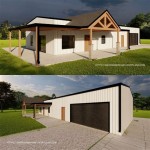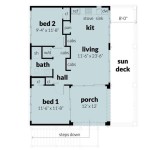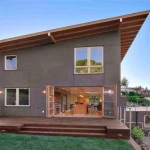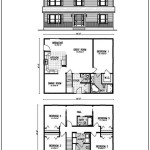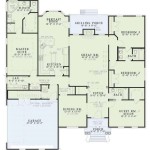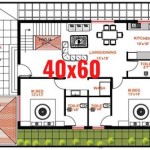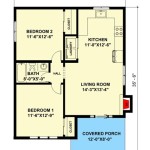Small Farmhouse Cottage House Plans: Blending Charm and Functionality
Small farmhouse cottage house plans represent a growing trend in residential design, appealing to individuals and families seeking a balance between rustic charm, efficient space utilization, and modern living. These plans are characterized by their emphasis on natural materials, comfortable layouts, and a connection to the outdoors, all within a compact footprint. This article will explore the key features, benefits, and considerations involved in selecting and implementing small farmhouse cottage house plans.
The popularity of small farmhouse cottage designs stems from several factors. Firstly, there's a desire for simpler living, prioritizing quality over quantity in terms of living space. Reducing the square footage of a home can significantly decrease construction costs, property taxes, and utility bills. Secondly, these designs cater to an aesthetic preference for warmth, character, and nostalgia. The farmhouse cottage style evokes a sense of comfort, connection to nature, and handcrafted detail, often contrasting with the sleek, minimalist aesthetics of contemporary architecture. Finally, advancements in architectural design and material science have made it possible to create smaller homes that are highly functional, comfortable, and aesthetically pleasing.
Key Architectural Features of Small Farmhouse Cottage Plans
Several distinctive architectural features characterize small farmhouse cottage house plans. These elements contribute to the overall aesthetic and functionality of the home, creating a space that is both beautiful and practical.
One of the most prominent features is a gabled roof. This roof style not only adds visual interest but also provides ample attic space for storage or potential future expansion. Gables are often adorned with decorative brackets or trim, further enhancing the farmhouse aesthetic. Variations in the gable design, such as dormers or cross gables, can create unique architectural details and increase natural light within the home.
Porches are another essential element of farmhouse cottage plans. Front porches, often covered, provide a welcoming entry space and a place to relax and enjoy the outdoors. Back porches or patios extend the living space and offer opportunities for outdoor dining and entertainment. The size and style of the porch can be customized to suit individual preferences and site conditions. Common porch materials include wood decking, brick pavers, and stone.
Exterior cladding materials play a crucial role in defining the farmhouse cottage style. Traditional choices include board-and-batten siding, shiplap siding, and clapboard siding. These materials evoke a sense of rustic charm and are often painted in neutral colors such as white, gray, or beige. The use of contrasting trim colors around windows and doors can add visual interest and highlight architectural details. Stone accents, such as a stone foundation or chimney, are also common in farmhouse cottage designs.
Windows are strategically placed to maximize natural light and ventilation. Double-hung windows are a classic choice, often paired with shutters for added architectural detail. Casement windows and awning windows can also be incorporated to provide specific ventilation and lighting solutions. The use of multiple windows, including small windows in bathrooms and hallways, helps to create a bright and airy interior.
Interior spaces in small farmhouse cottages often feature open floor plans. This design approach creates a sense of spaciousness and allows for easy flow between living areas. The kitchen, dining area, and living room are often combined into a single, multi-functional space. High ceilings and exposed beams can further enhance the feeling of openness. Built-in storage solutions, such as bookcases, cabinets, and window seats, help to maximize space and minimize clutter.
Fireplaces are a common feature in farmhouse cottage living rooms, providing a focal point and a source of warmth. Traditional wood-burning fireplaces can be used, or modern gas fireplaces can be installed for convenience. Fireplace surrounds are often constructed from brick, stone, or reclaimed wood, adding to the rustic charm of the home.
Optimizing Space in Small Farmhouse Cottage Plans
Given the limited square footage of small farmhouse cottage homes, maximizing space is a critical consideration. Careful planning and innovative design solutions are essential to creating a comfortable and functional living environment.
Vertical space is often utilized to its full potential. Loft areas can be created to serve as bedrooms, offices, or storage spaces. Cathedral ceilings can add height and drama to living areas, making them feel larger. Open staircases can minimize the footprint of the staircase while allowing natural light to flow through the home. Multipurpose rooms are popular, for example, a guest room might be designed to function as a home office or a craft room when not in use as a guest room.
Storage solutions are crucial in small homes. Built-in storage, such as shelving, drawers, and cabinets, can be incorporated into walls and under staircases. Closets should be carefully planned to maximize storage capacity. Vertical storage systems, such as wall-mounted racks and shelves, can help to keep floors clear and organized. Utilizing attic and basement space for storage can free up valuable living space on the main floors. Under-bed storage and ottoman storage are simple and effective solutions.
Furniture selection is another important aspect of optimizing space. Multi-functional furniture, such as sofa beds, folding tables, and nesting chairs, can adapt to different needs and maximize the use of space. Smaller-scale furniture is generally preferred in small homes. Wall-mounted furniture, such as desks and shelves, can free up floor space and create a more open feeling. Using mirrors to reflect light and create the illusion of more space.
The kitchen design in a small farmhouse cottage should be both functional and aesthetically pleasing. Compact appliances, such as apartment-sized refrigerators and dishwashers, can save space. Open shelving can create a more open and airy feel. A kitchen island can provide additional counter space and storage. A breakfast bar can serve as a dining area and a workspace.
Outdoor spaces can be integrated seamlessly with the interior of the home, extending the living area and blurring the boundaries between indoors and outdoors. French doors or sliding glass doors can connect the living room to a patio or deck. A small garden can provide fresh herbs and vegetables. A well-designed landscape can enhance the beauty and privacy of the home. Consider designing a small, covered patio or pergola to maximize outdoor living space throughout the year.
Considerations When Choosing a Small Farmhouse Cottage Plan
Selecting the right small farmhouse cottage house plan requires careful consideration of individual needs, lifestyle, and site conditions. Several factors should be taken into account before making a decision.
Budget is a primary concern for most homeowners. The cost of building a small farmhouse cottage can vary depending on the size of the home, the materials used, and the location. It is important to establish a realistic budget and to research construction costs in the local area. Obtaining multiple bids from contractors can help to ensure that the project stays within budget.
Lot size and orientation are also important factors. The size of the lot will determine the maximum size of the home that can be built. The orientation of the lot will influence the amount of sunlight the home receives. Consider the placement of the home on the lot to maximize privacy and views. Understanding local zoning regulations is critical before purchasing land or finalizing plans.
Lifestyle and family needs should be carefully considered. The number of bedrooms and bathrooms required will depend on the size of the family and the frequency of guests. The need for a home office, a playroom, or a hobby room should also be taken into account. The layout of the home should be designed to accommodate the family's daily routines. A single-story plan might be preferable for elderly individuals or those with mobility issues.
Future expansion possibilities should be considered. If there is a possibility of adding to the home in the future, the plan should be designed to accommodate this. For example, the foundation may be designed to support a future addition, or the attic may be designed to be finished into a living space. Planning for future needs can save time and money in the long run.
Energy efficiency is an important consideration for any home, but especially for small homes. Energy-efficient windows, insulation, and appliances can significantly reduce utility bills. Solar panels can provide a renewable source of energy. Consider incorporating passive solar design principles to maximize natural heating and cooling. A well-insulated home will be more comfortable and less expensive to operate.
Local building codes and regulations must be followed. These codes ensure that the home is safe and structurally sound. It is important to work with a contractor who is familiar with local building codes and can navigate the permitting process. Failure to comply with building codes can result in costly delays and fines.
Finally, customization options should be considered. Many small farmhouse cottage house plans can be customized to suit individual preferences. Changes can be made to the floor plan, the exterior finishes, and the interior details. Working with an architect or designer can help to create a home that is both functional and beautiful, while staying true to the farmhouse cottage aesthetic.

10 Small House Plans With Open Floor Blog Homeplans Com

New Beautiful Small Modern Farmhouse Cottage

Tiny House Plans For Farm Style Cottages

New Tiny House Plans Blog Eplans Com

Small Farmhouse Style House Plan 8317

Trend Alert Small Farmhouse Plans Blog Floorplans Com

Tiny Farmhouse Cottage Small Homes House Plans

Plan 80849 Small Country Cabin Or Lake House With 960 Sq F

Cottage House Plan 041 00279 With Interior
:max_bytes(150000):strip_icc()/SL-731_FCP-83e310d6c4f4422a88bd36464339bf30.jpg?strip=all)
26 Tiny House Plans That Prove Bigger Isn T Always Better


